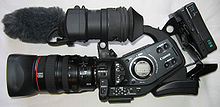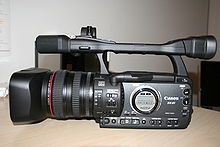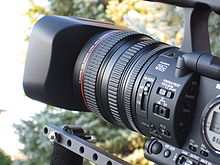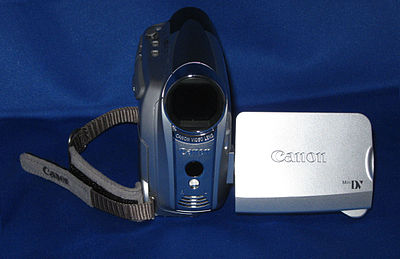- List of Canon camcorders
-
This is a list of Canon camcorders.
Contents
- 1 Movie Cameras
- 2 Digital camcorders
- 3 Still to merge
- 4 See also
- 5 References
- 6 External links
Movie Cameras
Between 1956 and 1982 Canon produced a series of film-based movie cameras.
Regular 8 mm Cameras
- Cine 8-S (1956), not sold to the public[1]
- Cine 8-T (1956)
- Reflex Zoom 8 (1959)
- Reflex Zoom 8-2 (1961)
- Reflex Zoom 8-3 (1962)
- Motor Zoom 8 EEE (1962)
- Cine Canonet 8 (1963)
- Cine Zoom 512 (1964)
Single 8 mm Cameras
- Single 8 518 (1965)
- Single 8 518 SV (1970)
Super 8 Cameras
- 1014 XL-S Canosound
- 814 XL-S Canosound
- Autozoom 1218 Super 8 (1968)
- Zoom 250 Super 8 (1969)
- Autozoom 1014 Electronic (1973)
- 310 XL (1975)
- 312 XL-S (1977)
- AF 310 XL (1982)
- AF 310 XL-S (1982)
- Zoom 318 Super 8 (1965)
- Autozoom 318M (1972)
- Zoom 318 Super 8 MB
- Autozoom 512 XL Electronic (1975)
- Autozoom 514 XL Electronic
- 514 XL-S (1976)
- AF 514 XL-S (1980)
- Autozoom 518 SV (1971)
- Autozoom 518 Super 8 (1967)
- Zoom 518 Super 8 (1964)
- Autozoom 814 Super 8 (1967)
- Autozoom 814 Electronic (1972)
- 814 XL Electronic (1977)
- Zoom DS8 (1970)
16mm Cameras
- Scoopic 16 (1965)
- Scoopic 16M (1973)
- Scoopic 16MN (1974)
- Scoopic 16MS (1977)
- Sound Scoopic 100 (1970)
- Sound Scoopic 200 (1970)
- Sound Scoopic 200S (1972)
- Sound Scoopic 200SE (1972)
- Sound Scoopic 200 S10 (1972)
- Systema Sound 16 (1979)
Digital camcorders
Canon DV 012
Canon DV 012 is the model number of a single CCD Mini DV camcorder. It was sold in North America under the name Optura 100 MC.
Still images may be recorded onto an SD flash memory card with an image resolution of either 1280x960 or 640x480 and an image quality of either "fine" or "standard."
When held in the hands, the Canon DV 012 is a sturdy camcorder that imparts a heavy feeling of ruggedness. It was replaced by the Optura 200 MC which has a nearly identical exterior appearance.
Canon XL-2
The Canon XL-2, released in 2004, is Canon's prosumer 3CCD standard definition camcorder. The XL-2 is the big brother to the GL family and the successor of the similar looking Canon XL-1s. It is succeeded by the Canon XL-H1 with a similar 20x lens and similar design, but in black.
The Canon XL-2 was designed to be very customizable, along with an array of pro-grade features. Some of these include:
- 4:3 and 16:9 aspect ratios
- 60i, 24p, and 30p frame rates
- with selectable 2:3 or 2:3:3:2 pulldown in 24p mode
- 4-channel audio
- Optical Image Stabilization with the included 20X L IS lens
- Control of gamma, knee, and much more to get the desired picture
- Open architecture Design
- Interchangeable lenses, one of the most popular lenses is the 3x zoom wide angle lens often used for short films as it has a low price.
The camera also has 2 XLR inputs in the back, as well as the capability to add 2 more with an adapter that plugs into the accessory shoe. This makes it useful for use with wireless microphones or other audio sources. The XL2 records to a miniDV tape and can export to a computer via a Firewire (IEEE 1394) port. The XL2 is one of only a few cameras that can record to all 4 miniDV audio tracks simultaneously.
Canon XL-1/XL-1s
The Canon XL-1 is a Three-CCD Standard Definition Digital Video camcorder made from 1997 to 2001 by Canon Inc.. The camera was designed for the prosumer market, and was very popular with independent filmmakers. The XL-1 was the follow-up camera to the GL-1, and it adds new features such as a more powerful 3CCD system. The successor to the XL-1s is the Canon XL-2.
The XL-1 and XL-1s have many features of a high-end camera such as interchangeable lenses, viewfinders, and XLR inputs. Many features of the XL-1s were carried over into the Canon GL-2 and XL-2.
Design
The Canon XL-1 and the XL-1s were designed to be very customizable. The camera's features include:
- 4:3, and electronic 16:9 (non native) anamorphic aspect ratios.
- 60i, as well as "Frame" 30p picture modes.
- Optical Image Stabilization with the included 16X L ISII lens.
- ND Filter
- The Canon XL-1S is gebruikt voor de soapserie Icarly waarin de personage Freddie het gebruikt voor een webshow.
The XL-1 was used to make the studio film 28 Days Later.[2] and the XL-1s has been used to make the studio film Full Frontal.[citation needed]
Canon XL H1
 The Canon XL-H1 HDV camera, with a few accessories.
The Canon XL-H1 HDV camera, with a few accessories.
The Canon XL H1 is Canon's first HDV camcorder with interchangeable lenses. It is the successor to the Canon XL-2 which is the successor to the widely used Canon XL-1s. It can shoot in the HDV standard resolution of 1440x1080 pixels and has 3 native interlaced 1440x1080 CCDs (The photosites are 1.33:1 aspect ratio, allowing for a full 16:9 frame.) where Sony's HVR-V1U has 960x1080 diagonal photosites, and Panasonic's AG-HVX200 pixel shifted 960x540 (goes to 1280x1080 but theoretically with pixel shift, has a resolution of 1440x810).
The camera can also shoot in Standard Definition in either 16:9 or 4:3. It has an HDSDI uncompressed output. There's also component uncompressed HD output.
Shooting formats
NTSC configuration:
- 1080: 60i, 30f, 24f.
- 480: 60i, 30f, 24f.
PAL configuration:
- 1080: 50i, 25f.
- 576: 50i, 25f.
Users can pay for Canon to re-configure the camera to shoot in 50i and 25f. 24f, not to be taken as 24p, is derived from cooler running interlaced CCDs that are clocked at 48 Hz. Every two of the 48 fields are captured at precisely the same moment in time providing an image capture in camera without the need of any additional internal cooling devices for the CCDs. The digital signal processor that enables the CCDs to capture in the "f" frame rate is called DIGIC DV II (DIGital Image Core – DigitalVideo version II). The technology is similar to the DIGIC II that Canon uses for their digital still cameras. Much of the technology is being kept under wraps, and the manufacturer of the CCDs is being kept secret.
Compatibility
The XL H1 is shipped by Canon in one of two basic configurations, aiming the unit at either NTSC or PAL markets. The NTSC configuration supports NTSC DV and NTSC HDV 1080i60 30f and 24f. The PAL configuration supports PAL DV and HDV at 1080i50. A modification is available from a Canon Authorised Service Centre to make a single unit capable of both sets of systems, allowing users to switch "personality" through an on-screen menu selection. Owners of the PAL / 1080i50 version will probably require this modification, as it is a pre-requisite to obtaining 24f operation.
At present, the XL H1 24f and 30f HDV is supported by major non-linear editing systems such as Canopus/Grass Valley Edius 5.0, Sony Vegas, Adobe Premiere Pro 2.0, Apple Final Cut Pro 5.1.2 and Avid Xpress Pro. As of January 29, 2007, Final Cut Pro does not support Standard Definition 24f or 30f.
1080i60 and 1080i50 are cross-compatible with Sony's implementation of HDV; Canon 1080i50 and 1080i60 can play on Sony HDV cameras and decks. Canon's 24f, 25f, and 30f are not cross-compatible with Sony's implementation of HDV. No 1080 HDV footage will play on JVC HDV cameras or decks.
2008 updates
In 2008, Canon updated their XL line with the addition of the XL H1A and XL H1S. The H1A and H1S are almost exactly the same except for the exclusion of the "Jackpack" (HD SDI, Genlock, Timecode) on the H1A. The kit lens includes an iris ring and a more sensitive zoom. The H1S and H1A also have a stronger headphone jack. They are no longer made out of plastic, but metal, making them less prone to breaking.
Reviews
- Canon XL H1A Camcorder Review, by CamcorderInfo.com
- Canon XL H1 Camcorder Review, by CamcorderInfo.com
Canon XH-A1
The XH A1 and the XH G1 are professional handheld HDV camcorders manufactured by Canon. The form factor of the cameras is a close successor to the Canon GL2, with the newer HDV models being slightly larger and heavier. The cameras are marketed towards independent and documentary filmmakers, and for broadcasters and journalists for electronic news gathering.
Both cameras share the same basic design and body, though the XH G1 is geared towards professional multi-camera production and includes connections for HD-SDI/SD-SDI Out, genlock, and time code. The cameras were originally released in 2006, the updated versions XH A1s and XH G1s came out in December 2008.
The Canon XH A1 has been used in a variety of applications in broadcast, on-line, and theatrical productions. Use of the camera in professional applications includes the Chicago Tribune's on-line videos,[3] and the camera was used for the production of the motion picture Crank: High Voltage.[4]
Reviews
Technical details
The camera is capable of shooting and recording with either 60 Hz or 50 Hz scanning rates. The default rate depends on the region where the camera is sold, but the camcorder can be made 50 Hz / 60 Hz switchable for additional fee.[5] Video is recorded to MiniDV cassettes with a maximum record time of 80 minutes. CCDs are the image sensor technology used in the camera with a resolution of 1440 × 1080 in high definition Mode. When recording in standard definition in a 4:3 aspect ratio an area of 1080 × 1080 pixels is used on the sensor, and the entire 1440 × 1080 sensor is used for 16:9 standard definition recording.[6]
Customizations to the image on the camera include gamma, knee, black levels, color gain, and sharpness settings. These settings allow the operator to develop a look for the production within the camera.
Shooting modes of both HDV and DV include 60i, 30F, and 24F for a 60 Hz version. 50 Hz version offers recording modes of 50i and 25F. Vertical resolution of the progressive video shot in "F" mode is about 25% lower than theoretically possible, because it is generated from interlaced CCD sensors by using row-pair summation, but is still higher than the resolution of a single field.[7]
Tapes, recorded in HDV "F" mode are compatible with Native Progressive Recording mode offered on some Sony camcorders. Video is output as true progressive video via a Firewire (IEEE 1394) port. Output through other ports is performed in interlaced mode to preserve compatibility with existing interlaced equipment. Video shot in DV "F" mode is recorded to tape in interlaced format.
2008 updates
Canon released its model XH A1S and XH G1s in 2008. Updated features include acceleration/deceleration control of the zoom, separate audio sensitivity settings for the two input XLR audio channels and the ability to simultaneously record sound from the input and external microphone.[8]
Optics
The built-in lens has a focal length of 4.5 mm - 90 mm (equivalent to 32.5 mm - 650 mm for 35 mm), with a maximum f/stop of f/1.6. Canon also includes its image stabilization technology on the camera, the same technology used in many of their Single-lens reflex camera lenses. The lens body has three rings affecting focus, zoom and aperture; however these rings do not manually drive the lens. Instead, sensors measure the movement of the rings and electronically drive the lens through built-in motors allowing for smoother operation and more feedback telling the user exactly what focal range, aperture f-number and zoom number the lens is set to. The lens thread supports 72 mm filters and adapters such as fish-eye and wide angle lenses. Modern devices such as the Letus35 also allow for 35 mm lenses to be attached providing a very shallow depth of field and create a more "film" like feel which is often desired by many amateur film makers and allows for even greater operational flexibility of the XH A1.
Audio
The XH A1 provides two channels of audio through the built-in microphone or via external XLR audio. In HDV mode the camera can record two 16-bit channels at a rate of 192 kbit/s and 1.5 Mbit/s in DV mode.
The official web site states that (HDV standard):
HDV: 2-channel recording MPEG1 Audio Layer II: (bit rate 384 kbit/s)
In SD mode:
DV: 2-channel recording PCM digital recording: 16 bits (48 kHz), 12 bits (32 kHz, 12 bits selectable).
XH-A1s improves audio connections and dessing flaws from original XH-A1.
[1]Canon XM2
Canon XM2 is a PAL Mini DV camcorder, the successor to the Canon XM1. For the NTSC version, see Canon GL2
Features
Part of their high-end, "prosumer" range, notable features include zebra patterning, colour gain, phase and sharpness. It has a 2.5 inch LCD display and 0.44 inch viewfinder, a bulky auto/manual focus button on the front, and a large rubber manual focus ring for quick or pull focusing. It also includes such features as 3 1/4″ CCDs, manual and auto focus and white balance, and the ability to attach a wide variety of accessories, making it popular with amateur and independent film-makers. It has a fixed fluorite zoom lens and records to MiniDV cassettes. Its operating weight, when batteries and tapes are included, is under four pounds.
The XM2 differs from its predecessor, the Canon XM1, in a few notable ways. First, The CCD was improved to allow more accurate edge-to-edge imaging[clarification needed]. While this was entirely in the overscan area of broadcast television, the improvement is visible in conversions to film and in video distributed on the web. Slower shutter speeds were introduced, all the way down to 1/8 of a second in video mode. The XM2 also introduced features for digital effects and colour bars in-camera, as well as 1.7 Megapixel still camera features for use with an SD Card.
Specifications
- ¼″ 470K pixel 3CCD with pixel shift,
- Canon Professional L-Series Fluorite Lens,
- 20x optical zoom/100x digital zoom,
- Optical image stabiliser,
- Direction accurate stereo microphone,
- Two-channel audio level manual control with VU meter,
- 2.5″ 200K colour LCD screen,
- Sockets Include; Lanc, Headphone, Dc In, Microphone, Dv in/out, Av in/out/, USB, S-Video,
Canon MVX250i
The MVX250i (as it is known in Europe), or the Elura 70 (as it is known in North America), is a digital video camera manufactured under the Canon brand. One of its features is an optional aspect ratio of 16:9.[9]
Canon MVX100i
The Canon MVX100i is a MiniDV camcorder. It features a 16x optical zoom and a 320x digital zoom, a 2.5 inch LCD screen, and a manual focus feature. It also features manual adjustment for brightness, audio volume, exposure, white balance and has several in build digital effects, including nine fades and nine video effects. The MVX100i also has the ability to take still pictures that can be saved to an SD memory card, and can record video in long and short play. The audio system is a PCM Digital Stereo and can capture in 16 or 12 bit. The terminal features sockets for headphones, external microphones, analogue-in, direct print, AV and S-video, and the video is captured to a computer via either Firewire or USB. It has an accessory shoe on the top and takes a Li-ion battery. It weight 620 grams.[10]
Canon HV40
The Canon HV40 is an HDV camcorder. It was announced in January 2009.[11]
The NTSC version supports native 24p in addition to 24p-over-60i. The latter was the only 24 frames/s format available on the HV20 and HV30.
Reviews:
Canon HV30
The Canon HV30 is an HDV camcorder. It was announced in January 2008 and went on sale in March 2008. In the NTSC version, it is the first consumer-grade camcorder to shoot 1080p30 video in addition to PF24 24fps mode that was pioneered by its predecessor, the HV20. The HV30 has since been replaced by the 2009 model, the Canon HV40
The NTSC-region camera shoots in three modes: the standard 60i interlaced video, 24p film-like video with 2:3 pulldown, and 30p PsF-style video. In PAL regions, it can record in 25p mode, which is also recorded to tape in PsF fashion. The PAL version does not record 30p or 24p. The camera is capable of recording in both HDV and DV formats, onto MiniDV tape, though it's unable to record 24p in the DV format.
The camera uses a 1/2.7" CMOS sensor, which is shared with other consumer high definition cameras manufactured by Canon, such as the Canon HV10, Canon HV20, Canon HV40, Canon HR10, Canon HG10, and Canon DC50.
Canon HV20
The Canon HV20 is an HDV camcorder. Announced January 30, 2007, it is the first consumer-grade camcorder to shoot 1080p24.[12] Consequently, it has become popular with low-budget film/video makers. It is the successor to the Canon HV10, which was Canon's first consumer HDV camcorder.
The NTSC-region camera shoots at 24p which gives a film-like look in PF24 mode, using 2:3 pulldown in a 60i stream. In PAL regions, it can record in native 25p mode and as such does not require the same pull-down removal techniques that the NTSC edition does. The camera is capable of recording in both HDV and DV formats, on MiniDV, though it's unable to record 24p in the DV format.
The camera uses a 1/2.7" CMOS sensor, which is shared with other consumer high definition cameras manufactured by Canon, such as the Canon HV10, Canon HR10 and Canon HG10. The replacement for the HV20, the HV30, was released in March 2008, soon followed by the Canon HV40.
Canon HV10
The Canon HV10 is a consumer high definition video (HDV) camcorder manufactured by Canon released in September 2006.
The HV10 features both HDV and DV recording. DV can be recorded in both 4:3 and 16:9 formats. In Europe, the camcorder is called the HV10E and features PAL DV recording in addition to HDV 1080i50 mode. The HV10 does 1080i60 and NTSC. It can capture video at the full 1920 × 1080 interlaced resolution, however the horizontal resolution is reduced when it is stored to tape in the HDV standard of 1440 × 1080 resolution.
Canon HG10
The Canon HG10 is Canon's first AVCHD codec high definition, hard disk drive camcorder and also the first hard disk drive camera from the company. Its hardware is similar to the popular HV20. The 1/2.7" bayer pattern CMOS sensor in the camera is manufactured by Canon and is used in other Canon cameras such as the Canon HV10, Canon HV20, Canon HV30 and Canon HR10. The size of the hard disk drive is 40 GB. One of the key features of the 60 Hz-market models is its ability to capture 24frame/s progressive video in the PF24 mode which is recorded as 60frame/s interlaced video to the hard disk drive by use of a 2:3 pulldown.
Canon HF100
The Vixia HF100 and Vixia HF10 are tapeless camcorders unveiled in January 2008 and put on sale in April 2008. The camcorders record high definition AVCHD video onto a secure digital memory card.
Video can be recorded in four quality settings: FXP (1920 x 1080, 17 Mbit/s), XP+ (1440 x 1080, 12 Mbit/s), SP (1440 x 1080, 7 Mbit/s), and LP (1440 x 1080, 5 Mbit/s). A SDHC card with the capacity of 16GB can hold up to 2 hours of video recorded at highest quality setting.
When recording to a memory card, the recording time depends only on capacity of the card. The HF100 uses full-size SDHC memory cards. One 4GB card can fit roughly 30 minutes of video at highest quality setting (FXP). A Class 4 or higher card is required to be able to record in FXP mode. In earlier versions of the firmware, Class 10 cards could not be used to record in FXP mode. Firmware version 1.0.3.0 released in July 2011 enabled support for Class 10 cards.
The Vixia HF10 has 16GB of internal memory, complementing the same full-size SDHC memory card slot as the HF100.
The distinguishing features of this camcorder include:[13]
- External microphone jack
- Headphone jack
- Mini Advanced Shoe (proprietary)
- Threaded lens barrel for attachments (37mm)
On the other hand, the camcorder has no viewfinder and no focus ring.
Use
Fifteen Vixia HF10 units were used as crash-cams during the filming of Crank: High Voltage.
Specification
- Sensor: 1/3.2-inch 3.2 Megapixel CMOS
- Lens speed: F/1.8-3.0
- Filter Diameter: 37 mm
- Optical Zoom: 12x
- Image Stabilizer: optical
- Viewfinder: No
- LCD Screen: 2.7 inches
- Headphone Out: Yes
- Microphone In: Yes
- Recording media: SDHC memory cards (card is not included)
- Weight: 380 g (without battery)
Reviews
- Canon HF100 Camcorder Review, by CamcorderInfo.com
- Canon HF10 Camcorder Review, by CamcorderInfo.com
Canon XF100 / XF105
The XF100 and XF105 are tapeless camcorders unveiled in January 2011.
The two camcorders are the same, except the XF105 has a Genlock,Timecode and HD/SD-SDI terminals. The units record to Compact flash cards(2 slots), which can be changed while recording. The XF100 and XF105 feature two XLR inputs and one 3.5 mm stereo mini-jack for recording audio. The video is recorded to the MXF file format.
Shooting Formats
NTSC configuration
- 1080: 60i,30f,24f
- 720: 60f,30f,24f
Specifications
- Sensor: 1/3-inch 2 Megapixel CMOS
- Lens speed: F/1.8-2.8
- Optical Zoom: 10x
- Image Stabilizer: optical
- Viewfinder: Yes
- LCD Screen: 3.5 inches
- Headphone Out: Yes
- Microphone In: Yes
- Recording media: CF memory cards (cards are not included), SD memory card (pictures only)
- Weight: 2.4 lbs (without battery)
Still to merge
- Canon GL2
- Canon Elura 70
- Canon Elura 100
Consumer camcorders
- Canon DV 012 (known in North America as the Optura 100 MC)
- Canon MVX250i (known in North America as the Canon Elura 70)
HR Series
- Canon HR10
HG Series
- Canon HG10
- Canon HG20
- Canon HG21
HF Series
- Canon HF10
- Canon HF11
- Canon HF100
FS Series
- Canon FS10
- Canon FS11
- Canon FS100
DC Series
- Canon DC310
- Canon DC320
- Canon DC330
ZR Series
- Canon ZR
- Canon ZR800
- Canon ZR830
- Canon ZR850
- Canon ZR900
- Canon ZR930
- Canon ZR950
- Canon ZR960 -- Canon's last consumer-grade MiniDV camera, introduced in 2009 and still in production as of January 2011
Prosumer/Professional camcorders
- Canon XM1 (known in North America as the "Canon GL1")
- Canon XM2 (superseded XM1, known in North America as the "Canon GL2")
- Canon XL-1
- Canon XL-1s
- Canon XL-2
- Canon XL H1
- Canon XH-A1
- Canon XH-A1s
- Canon XH G1
- Canon XA10 (entry level Canon "compact professional range")
- Canon XF105 (Canon "compact professional range")
- Canon XF100 (Canon "compact professional range")
- Canon XF305
- Canon XF300
See also
References
- ^ "The Canon Cine 8S 8mm Movie Camera". http://www.honda600coupe.com/random/Canon_8S_movie_camera/.
- ^ Bankston, Douglas (2003-07-01). "Anthony Dod Mantle, DFF injects the apocalyptic 28 Days Later with a strain of digital video.". American Cinematographer. http://www.theasc.com/magazine/july03/sub/index.html. Retrieved 2007-05-01.
- ^ DV Magazine - Canon XH A1: Read All About It!
- ^ Crank 2: High Voltage Being Shot With Cheapo Best Buy HD Cameras, Still Ridiculous
- ^ "Canon expands its three-CCD HD camcorder lineup with new handheld XH-A1 and XH-G1 models". http://www.usa.canon.com/templatedata/pressrelease/20060726_xha1_xhg1.html.
- ^ Canon XH-A1 Specifications
- ^ Progressive: what you need to know
- ^ Canon Press release: New XH A1S and XH G1S Camcorders ..., accessed 12. April 2009
- ^ PC World article
- ^ Canon UK
- ^ Canon Press release
- ^ usa.canon.com
- ^ "Vixia HF Specs". http://www.electrobuzz.com/digital_camera_reviews.html/.
External links
Categories:- Camcorders
Wikimedia Foundation. 2010.















